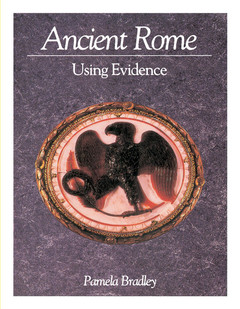Description
Ancient Rome: Using Evidence
Using Evidence
Author: Bradley Pamela
This text presents a detailed coverage of three crucial centuries in the history of the Roman people.
Language: English
Subject for Ancient Rome: Using Evidence:
Approximative price 25.19 €
Subject to availability at the publisher.
Add to cart
Publication date: 02-2000
664 p. · 18.6x24.2 cm · Paperback
664 p. · 18.6x24.2 cm · Paperback
Description
/li>Contents
/li>
This text presents a detailed coverage of three crucial centuries in the history of the Roman people: the second and first centuries BC and the first century AD. It examines major issues including the development of the Roman republican form of government, Rome's expansion in the Mediterranean, the decline of the republic, the founding of the principate and the Julio-Claudian period. The introductory chapters will familiarise students with the source material and give them an understanding of those events and influences which played a large part in moulding the character of the Romans and the nature of their institutions. These chapters are essential reading for any student who wishes to understand clearly the complicated political history of the second and first centuries BC. The ancient sources and archaeological material serve both to describe events and to allow students to evaluate and interpret historical documents and pictorial evidence. Throughout the text exercises enable students to recognise differing interpretations, distinguish between fact and opinion and discern bias.
List of illustrations; List of maps; Part I. Introduction to Roman History: 1. The evidence; 2. The geography of Italy and its influence on the development of Rome; 3. The foundation and early development of Rome; 4. Roman society in the early republic; Part II. The Roman Conquest of Italy and Constitutional Developent: 5. Conquest and organisation; 6. The plebeian struggle for equality and the government of Rome; Part III. Rome's Expansion in the Mediterranean, 264–146: Carthage, Macedonia, Greece and Asia: 7. Background to the wars with Carthage; 8. The First Punic War, 264–241; 9. Background to the Second Punic War, 229–218; 10. The Second Punic War, 218–201; 11. The Third Punic War, 149–146; 12. Rome and the east, 200–146; 13. The immediate and long-term effects of the wars of expansion; Part IV. The Late Republic: First Phase, 146–78: 14. The Gracchi; 15. marius and Sulla; Part V. The Late Republic: Second Phase, 78–28: 16. The rise of Pompey and the period of his eastern commands, 78–61; 17. From the First Triumvirate to the death of Caesar, 60–44; 18. From republic to principate, 44–28; Part VI. Augustus and the Julio-Claudians 28 BC–AD 68; 19. The principate of Augustus, 27 BC–AD 14; 20. The forums of Rome in the time of Augustus; 21. The Julio-Claudian dynasty, AD 14–68; 22. Life in an imperial city in the first century AD; Notes to the text; Glossary; Bibliography; Acknowledgments; Index.
© 2024 LAVOISIER S.A.S.

